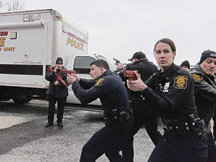As local students were off for winter break last week, the North Bergen Police Department began training for a worst-case scenario at their high school, preparing for how their patrol officers should respond in the case of an “active shooter” incident.
Immediate Action Rapid Deployment tactic training was a recommendation made by the U.S. Attorney General’s Office. The training, which every patrol officer underwent this past week, included three hours of classroom training, as well as four hours of practical training within the North Bergen High School.
Officers used a Simunition System, a “gun” that fires wax bullets, and learned from Lt. Peter Fasilis, along with Det. Steve Schubert, how to enter a building when there is a shooting taking place, how to enter stairways and classrooms, and how to be able to make quick judgments in such an event.
“We don’t want people going in guns blazing if someone has a hostage.” – Peter Fasilis
________
Fasilis said that while a shooting could occur anywhere, the school was a perfect place to train because of the many places someone could hide.
Police Chief William Galvin said that he was proud of the department’s training program and happy with the cooperation they have received from the North Bergen Board of Education.
“Thankfully, we have never encountered an incident of a school shooter; however, nationwide this is a growing concern and a topic the North Bergen Police Department does not take lightly,” said Galvin.
Columbine changed training
On April 20, 1999, two seniors at Colorado’s Columbine High School, Eric Harris and Dylan Klebold, unleashed fire on fellow students, killing 12 students and one teacher.
Fasilis said that police responded to the incident according to protocol that was used then.
“You secure the perimeter, you call for the SWAT team and you let the SWAT team handle the situation,” said Fasilis. “It worked for many years, [but after this] we had to re-think things, because then and now we could face a threat from within the school.”
After the Columbine High School massacre, police tactics changed so that police officers’ main prerogative was to “neutralize” the shooter at all costs in order to save as many lives as possible.
As a recent incident has shown, the threat could not only be a student but a teacher, as was the case in a shooting last year at the University of Alabama. Fasilis said that officers need to be prepared for a range of scenarios and the hundreds of options they could respond with.
Fasilis said that twice a year, police have “active shooter” training scenarios at the police academy and undergo deadly force training, but specialized training is needed for facing a shooting in progress.
He explained that in such an incident, officers may have to take the first action without contacting their supervisors.
Schubert said that it goes against most of the scenarios that officers are trained for.
“You basically have to look at it as the greater good because if you stop and slow that momentum down, this guy is going to continue killing or hurting people,” said Schubert.
Muscle memory
Officers last week practiced entering the high school in a diamond formation, with everyone protecting a “piece of the pie.” They also practiced bomb scenarios and how to approach a stairway, one of the most dangerous locations, said Fasilis.
He hopes to expand the training program, so that officers can know much more than these basics.
He also trained officers on how to handle the situation if hostages are involved.
“We don’t want people going in guns blazing if someone has a hostage,” said Fasilis. “Ninety percent of hostage situations are resolved without a shot being fired.”
D.A.R.E. Officer Joseph Sitty said the training they were receiving was top-notch.
“We need to know how to react to [a shooting] as we would likely be the first officers on scene,” said Sitty, speaking for himself and the school resource officers placed within the high school.
Tricia Tirella may be reached at TriciaT@hudsonreporter.com.
